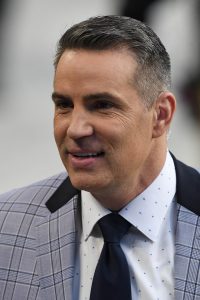One of the best rags-to-riches tales in NFL history (temporarily) came to an end on this date 17 years ago. While no one knew it at the time, the story still had years to go before its conclusion. On June 1, 2004, the Rams released veteran quarterback Kurt Warner.
 Warner, of course, went from an undrafted free agent and Arena Football League standout to NFL MVP. By the end of the 2003 campaign, Warner had easily cemented himself as one of the top athletes in St. Louis history. After getting thrust into the Rams starting lineup in 1999, the QB would go on to win a pair of MVPs, twice lead the NFL in touchdowns, and win a Super Bowl (along with a Super Bowl MVP). However, the wheels started to come off a bit during the 2002 season. Warner was limited to only six starts that season, with the Rams going 0-6 in those contests.
Warner, of course, went from an undrafted free agent and Arena Football League standout to NFL MVP. By the end of the 2003 campaign, Warner had easily cemented himself as one of the top athletes in St. Louis history. After getting thrust into the Rams starting lineup in 1999, the QB would go on to win a pair of MVPs, twice lead the NFL in touchdowns, and win a Super Bowl (along with a Super Bowl MVP). However, the wheels started to come off a bit during the 2002 season. Warner was limited to only six starts that season, with the Rams going 0-6 in those contests.
Warner was the starter to begin the 2003 campaign, but it somehow got worse. During his lone start, he had six fumbles, leading to his official benching. Meanwhile, fill-in Marc Bulger guided the Rams to a 12-3 record as a starter, cementing his spot as the Rams’ QB of the future. As a result, Warner found himself on the outs in St. Louis.
The writing was on the wall during the 2004 offseason. The Rams organization continued to work on a long-term pact with Bulger, and they also signed Chris Chandler to serve as the backup play-caller. So, with the June 1 deadline officially passing, the Rams decided to move on from Warner on this date in 2004. The move saved the Rams about $4.8MM in cap room while costing them about the same amount in dead cap, and they had to eat another $6MM-plus in 2005.
While Warner was reportedly seeking a starting gig following his release, he ultimately settled into a backup role as Eli Manning‘s mentor with the Giants. Warner actually had a chance to start at the beginning of the year, and he showed some improvement from his dreadful 2002 and 2003 campaigns. Still, he only finished with six touchdowns in nine starts, and the Giants voided the second-year of the QB’s contract at the conclusion of the season.
Warner added another chapter to his story in 2005. The veteran joined the Cardinals, and while he’d eventually earn a place in Arizona lore, it took a while for him to fully secure the starting gig. Thanks in part to injuries and the team’s desire to play top draft picks (including Matt Leinart), Warner only saw time in 16 games through his first two seasons with the organization, collecting a 3-12 record.
However, Warner experienced a career turnaround in 2007; his 27 touchdowns were his highest total since 2001. Then, Warner truly put himself back on the NFL map in 2008, earning a Pro Bowl nod after completing 67.1-percent of his passes for 4,583 yards and 30 touchdowns. More importantly, he guided his team to the Super Bowl, where he eventually lost to the Steelers. 2009 was another standout season for Warner, as he tossed 26 touchdowns while leading the Cardinals to a 10-5 record. However, that iteration of the Cardinals got blown out in the Divisional Round, and Warner announced his retirement soon after the season.
While no one thought Warner’s career was finished when he was released by the Rams on this date in 2004, few pundits probably envisioned him returning to the Pro Bowl, much less the Super Bowl. Just like Warner did during the early parts of his career, the QB managed to persevere and surprise during the second-half of his storied career.